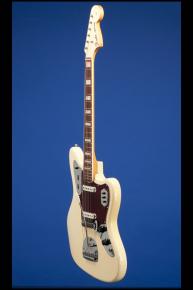A Fine Olympic White Early CBS Jaguar.
This "Olympic White" Jaguar weighs 8.70 lbs. with a nut width of just under 1 5/8 inches and a scale length of 24 inches. Solid alder body, one-piece maple neck with a medium profile, and bound veneer rosewood fretboard with 22 original medium-jumbo frets and inlaid pearl dot position markers. Headstock with matching "Olympic White" finish and decal with "Fender" in gold with black trim and "Jaguar" in black. Beneath that is "Pat. 2,960,900 2,972,923 3,143,028 2,741,146 Des. 186,826 Pat. Pend." and "Offset Contour Body" at the ball end of the headstock. Single "butterfly" string tree with nylon spacer. Individual Fender "F" Tuners with octagonal metal buttons. "F-Series" neckplate with the serial number "158834" stamped between the top two screws. The end of the neck is stamped "15 AUG 66B". Two white oblong Strat-like pickups with notched metal side plates and balanced outputs of 5.55k and 5.50k. Four-layer (tortoiseshell over white/black/white) plastic pickguard with ten screws. Two controls (one volume, one tone) and jack socket on lower metal plate adjoining pickguard on treble side, selector switch and two roller controls (one volume, one tone) on upper metal plate adjoining pickguard on bass side, and three slide switches on metal plate inset into the pickguard on the treble side. Black plastic Jaguar knobs. The pots are dated: "304 6612" (Stackpole, March 1966). Jazzmaster-type floating tremolo and bridge with adjustable mute. There are two 3/8 inch letters "ES" blind-stamped into the body between the neck and the bridge pickups (only visible when the pickguard is removed) which signify that this guitar was "Enter Special" as with many other 1966 Fender guitars. Complete with the original tremolo arm and bridge cover. This excellent example has some finish checking on the body and the back of the headstock, a small amount of belt-buckle scarring (nothing through the finish) and a few small edge marks/dings. The original frets show very little sign of wear and tghe original mute 'rubber' is still like new. Overall we can safely give this great playing and sounding CBS Jaguar a good solid (9.00) exceptionally fine condition rating. Housed in its original Fender black hardshell case with dark orange plush lining (9.00).
1966 and the "ES" Stamp. "The two-letter "ES" paint code means "Entered Special" for a special order or a show guitar. This does not indicate a factory refinish job, but was instead used by the factory to tell the finish booth to paint this body special order. Stamped number codes and letter codes mean different things… In 1966, Fender used the "ES" code a lot on their custom color instruments. At least for 1966, the ES code was used as some sort of default for custom colored instruments (be it Teles, or Strats or Jazz Basses). This two letters ("ES" for "Enter Special") seems to denote a special order, at least for 1966. Again this is has been seen lots of times on 1966 documented original custom color instruments." (http://www.provide.net/~cfh/fenderc.html)
"Not content with the relatively expensive Jazzmaster, Fender introduced a new top-of-the-line model in 1962: the Jaguar. [The pricelist offered a basic Sunburst Jaguar at $379.50; a similar Jazzmaster was $349.50]. Another offset-waist multi-control instrument, the Jag seemed an attractive proposition, but still failed to dent the supremacy of Fender's dynamic duo, the Tele and the Strat...The Jag used a similar offset-waist body shape to the earlier Jazzmaster, and also shared that guitar's separate bridge and vibrato unit, although the Jaguar had the addition of a spring-loaded string mute at the bridge. Fender rather optimistically believed that players would prefer a mechanical string mute to the natural edge-of-the-hand method. They did not. There were some notable differences between the Jaguar and Jazzmaster. Visually, the Jag had distinctive chromed control panels, and was the first Fender with 22 frets. Its 24" (610mm) scale-length ('faster, more comfortable') was shorter than the Fender standard of 25" (635mm) and closer to that of Gibson. It gave the Jag a different playing feel compared to other Fenders. The Jaguar had better pickups than the Jazzmaster. They looked much like Strat units but had metal shielding added at the base and sides, no doubt as a response to the criticisms of the Jazzmaster's tendency to noisiness. The Jag's electrics were yet more complex than the Jazzmaster's, using the same rhythm circuit but adding a trio of lead-circuit switches...The Jaguar was offered from the start in four different neck widths, one a size narrower and two wider than normal (coded A, B, C or D, from narrowest to widest, with 'normal' B the most common)" (Tony Bacon, 50 Years of Fender, p. 36).











